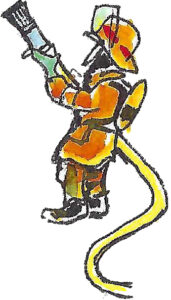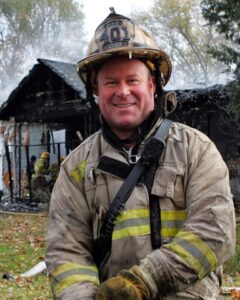Career Staffing Doesn’t Equal Readiness—Systems & Training Do #2
October 29, 2025Career Staffing Doesn’t Equal Readiness—Systems & Training Do
Predictable crews mean nothing without command systems, consistent training & regional coordination.
By John Vance
B Shifter Buckslip, Nov. 4, 2025
Across the fire service, a clear trend is emerging: Volunteer and paid on-call firefighters are increasingly being supplemented—or even replaced—by career personnel. Predictable staffing brings obvious benefits, but one truth often gets lost in the discussion: Hiring career firefighters does not automatically make a career department.
A true career department is not defined by paychecks or how many people staff a station; it is defined by systems, standards and scalable leadership practices. Without a strong command structure, predictable staffing only gets you halfway to safe and effective emergency response.
The Limits of Adding People
 Departments are adding career positions at a pace we haven’t seen before. The decreasing availability of on-call personnel and increasing service demands—fire suppression, EMS, technical rescue—make it seem like a logical step. Having people in the station 24/7 is a major advantage for turnout times, reliability and consistency.
Departments are adding career positions at a pace we haven’t seen before. The decreasing availability of on-call personnel and increasing service demands—fire suppression, EMS, technical rescue—make it seem like a logical step. Having people in the station 24/7 is a major advantage for turnout times, reliability and consistency.
But here’s the catch: In many cases, the number of career personnel added still falls short of what’s required to manage a working incident. Crews might be staffed around the clock, but the department still lacks the effective response force (ERF) needed to perform all the critical fireground functions simultaneously. In other words, staffing the station isn’t the same as staffing the fireground.
Start With Community Expectations
Whether career, combination or volunteer, before adding career staff, an organization must answer a fundamental question: What does the community expect from you?
- Does the authority having jurisdiction (AHJ) expect fires to be stopped at the room of origin, the building of origin or the block of origin?
- Is your ERF designed to meet that level of service?
- Do EMS benchmarks, such as cardiac arrest survival rates, drive your staffing and training models?
- Have you clearly identified the critical fireground tasks that crews must perform at every structure fire?
- Do your elected officials (those who control the budget) have a clear understanding of the public’s expectations and the simultaneous operations that must occur on the fireground?
5 Questions You Must Ask Before Adding Career Staffing
- What does our community expect? Define the service level: room of origin, building of origin or block of origin for fire suppression.
- Do we have an effective response force (ERF)? Adding one or two career positions doesn’t equal a full fireground force.
- How will we integrate career staff with volunteers? Clarity of roles, training and command language is critical.
- Do we have scalable systems in place? Predictable staffing without a structured command model creates fragility.
- Are we training regionally? Mutual and automatic aid only work when partners share SOGs, terminology, and expectations.
Bottom line: Career staffing strengthens your department—but it should be supported by systems, training, and partnerships.
Don’t Copy Big Brother
Wanting to look like a fully staffed department isn’t a plan. It’s tempting to emulate large urban fire departments and their systems by adding career personnel, but their models don’t translate to smaller or suburban agencies with limited staffing. In lightly staffed departments, firefighters must possess the skills to size up situations and take the appropriate action rather than relying on an automatic deployment system.
Some pitfalls when relying on automatic assignments or failing to train with the automatic-aid agencies you depend on during incidents include:
- Predetermined assignments fall flat when the first due arrives with a crew of one or two (plus they fail to identify critical fireground factors).
- Mutual aid loses effectiveness without common training or language.
- Command falls apart when different agencies use different practices.
Scalable Command Makes Even Smaller Departments Mighty
Smaller organizations need systems that work with the resources they actually have. That’s where scalable systems, like Blue Card, make the difference. Blue Card works whether you have two people or 20. It ensures deployment is systematic, incident commanders follow a repeatable process, and multiple jurisdictions can plug into the same model without confusion. A career firefighter isn’t defined by how many ride the rig; they are defined by how they function when the pressure is on.
Certify Commanders, Then Train Relentlessly
Let’s be honest: Incident management in the fire service has been inconsistent. Some officers get it, others don’t. And the consequences show up in chaotic scenes, missed opportunities and unsafe decisions.
What separates the good from the great? Mentorship, education and systems that make good habits repeatable. I learned this firsthand as a young firefighter. I witnessed both brilliant and disastrous decisions. The difference wasn’t luck—it was preparation.
Training and experience—not rank, titles or helmet color—make officers command-ready. Every department should:
- Certify incident commanders through a credible system.
- Require ongoing continuing education in command training.
- Incorporate simulations and after-action reviews into routine training.
- Focus on decision-making and tactics.
Common Training, Common Language
No fire department operates in isolation. Automatic and mutual aid are ingrained in fire service culture. But without shared SOGs, training and command language, collaboration turns into confusion. Departments that thrive regionally do three things consistently:
- Adopt common operational guidelines across jurisdictions
- Train regularly with their partners
- Use shared command routines and language
Shared operations and practices create safer, more efficient responses.

Regular meetings with automatic- and mutual-aid partners ensure common procedures and practices.
Systems Over Swagger
It’s easy to look the part: the helmet, the bugles, the radio voice. But substance is what saves lives. The best incident commanders don’t rely on swagger. They rely on systems. They’ve trained, repeated and reflected until the right decision is their default decision. Career staffing alone won’t give your department that foundation. Systems will.
Don’t Confuse Staffing With Readiness
The fire service is evolving. But adding career personnel without building structure creates fragility. Don’t let the presence of career staff create a false sense of readiness. A true career department runs on systems, not hope.
Certify your commanders. Train regionally. Build scalable routines. And invest in a command model that ensures clarity, order and consistency when everything else is chaos. At the end of the day, Mrs. Smith doesn’t care if your firefighters are career or volunteer. She cares that they’re ready to handle her worst day with skill, calmness and confidence.

John Vance recently retired as a fire chief after 22 years in the front office. He is currently a battalion chief with the Chanhassen (Minn.) Fire Department; he has been a chief officer since 2002. He is a proud Blue Card lead instructor and an accredited chief officer through the Center for Public Safety Excellence. John has a bachelor’s degree in fire service management from Southern Illinois University and a certificate in executive management from the University of Notre Dame. He is the host of the B Shifter Podcast.



